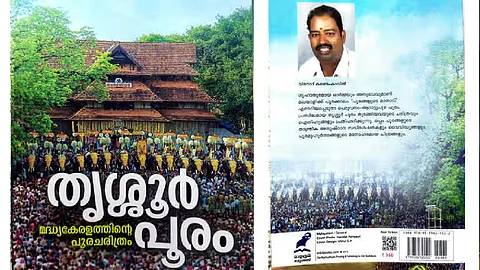

#Ajayan
Come March, Thrissur district dances in the rhythmic embrace of poorams, weaving a tapestry of cultural splendour. From the largest convergence of elephants at Arattupuzha to the symphony of classical melams unfolding in meticulously crafted arrangements at Peruvanam and finally to the illustrious Thrissur Pooram, the district becomes a canvas adorned with a myriad of cultural festivals, each stroke painting vibrant hues of tradition and celebration.
In his recently released book, 'Thrissur Pooram: Madhya Keralathintae Pooracharitram,' Vinod Kandemkavil delicately unravels the intricate tapestry of cultural festivals, meticulously documenting the minutiae of each participating temple. From the distinct traditions to the sacred rituals, Kandemkavil's literary brushstrokes elegantly bring to life the essence of these festivities. The book was handed over to melam maestro Kizhakoot Aniyan Marar by actor and caricaturist Jayaraj Warrier in Thrissur just last week, a fitting tribute to the rich cultural legacy it so eloquently explores.
History is that Arattupuzha was the venue where deities from across the breadth and width of the erstwhile Peruvanam gramam used to gather for the Pooram over 1,400 years ago. Over time, disparate poorams emerged locally, orchestrating their unique symphonies and thus was born Thrissur Pooram too.
Vinod, a permanent presence across all these festivities, divides his book into four parts, etching details of four different poorams that have emerged from the antiquity of Arattupuzha. The first of these records particulars of the Peruvanam-Arattupuzha Pooram, the different deities that gather at Peruvanam temple and the different melams that are there.
Vinod, an enduring witness to these revelries over years, intricately partitions his tome into four sections, meticulously inscribing the nuances of four distinct Poorams birthed from the ancient loom of Arattupuzha. The initial segment of his narrative chronicles the specifics of the Peruvanam-Arattupuzha Pooram—delving into the diverse pantheon of deities gracing the hallowed precincts of the Peruvanam temple and harmonizing the diverse melodic cadences that resonate within its sacred bounds.
Vinod unveils the intricate tapestry of rituals woven across the sacred landscape of the 24 temples converging for the celestial confluence of the 'devasangamam' at Arattupuzha Pooram. It is a spectacle that unfolds at the break of dawn, a vivid tableau where the radiance of the rising sun cascades upon the golden nettipattams adorning the foreheads of majestic elephants, accentuated by the flickering flames of the theepandham (flambeau) held before them.
Amid this grandeur, there is the gracious farewell bestowed upon the Triprayar Thevar, the esteemed deity presiding over the festivities. The Arattupuzha Thevar, in a ritualistic procession spanning seven fields, expresses gratitude to the honoured guest and imparts the date of the forthcoming Pooram. There is then the graceful journey of the gramabali, where an adorned elephant embarks on a pilgrimage through diverse villages. At each crossroad, waterbody and beneath the canopy of venerable trees, offerings are ceremoniously presented, elevating the essence of the ritual to a sublime communion with nature.
The book details the Thrissur Pooram and the rituals followed each day at the 10 temples that gather there on Pooram day, the Kuttanellur Pooram and its five deities and the Manikyamangalam Pooram. Not to stop at that, he also gives pen pictures of the festivals of a few temples in neighbouring Ernakulam district.
Vinod unravels the splendour of the Thrissur Pooram, delving into the intricacies of the daily rituals observed across the 10 venerable temples assembled on the auspicious Pooram day. The narrative gracefully extends to the Kuttanellur Pooram, painting vivid portraits of its five revered deities, and further goes out to reach the Manikyamangalam Pooram.
The narrative does not cease its exploration there. Vinod extends his literary brushstroke to capture the essence of festivals in neighboring Ernakulam district, providing evocative pen pictures that breathe life into the sacred celebrations of temples there.
In the foreword, the erudite Thiyyadi Krishnan Nambiar aptly notes that, unlike previous literary endeavours centered around Poorams, Vinod's work distinguishes itself by delving into the enigmatic realm of tantric rituals, embracing the rich tapestry of diversities, and meticulously unraveling the intricate customs intricately woven into the fabric of these celestial festivals. Vinod's work transcends conventional boundaries, shedding profound light on the esoteric dimensions that have hitherto remained veiled in the shadows of lesser-explored nuances.
